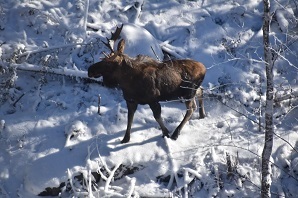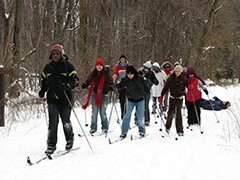Wildlife, Fish, and Marine Life Newsletter
The New York State Department of Environmental Conservation sent this bulletin on 02/01/2023 02:00 PM EST |
| DEC Delivers - Information to keep you connected and informed from the NYS Department of Environmental Conservation |
| View in browser |
Wildlife, Fish & Marine Life Newsletter |
New York’s Moose Are Back…Hopefully for Good
Moose have been present in the northern portion of New York since the Pleistocene (period of time spanning about 2.6 million to 11,700 years ago). However, by as early as the 1860s overhunting and habitat degradation had eliminated moose from New York. In response, a handful of small-scale moose restoration efforts were undertaken between 1870 and 1902 by private landowners and the NYS Fish, Forest and Game Commission, but were not successful. Over the next eighty years there were periodic moose sightings, but it wasn’t until 1986 that DEC staff documented a small population of resident moose in the Adirondacks that may have immigrated from Vermont, Massachusetts, or Quebec. Around 2010, it was thought that the population that started with only 6-11 individuals had grown to many as 400! Over the past eight years, DEC has partnered with Cornell University and SUNY College of Environmental Science and Forestry to monitor and assess the health and stability of New York’s moose population. Researchers determined that there were approximately 700 moose (as of 2019) located within the Adirondack Park. They also evaluated food availability and determined there was enough food on the landscape to support a larger population. Their study of GPS-collared adult cows (females) found that there was limited movement of these individuals to other areas, suggesting that these cows had enough local resources to establish home ranges, breed, and produce calves. These studies suggest that New York’s moose population is stable or potentially growing. The first two years of a moose’s life can be the hardest due to winter conditions and an increased susceptibility to pathogens and parasites. Because of this, over the past two winters DEC partnered with Cornell University and Native Range Capture Services to catch 30 calf and yearling moose. All captured individuals were outfitted with GPS-tracking collars, which will self-release after two years of data collection. This study will help researchers assess how many calves and yearlings are surviving to breeding age. DEC will continue to monitor the population and potential threats to hopefully give moose the best chance of maintaining a healthy and viable population in New York into the future. Photo by Erika Schwoyer. It’s a boy! And a girl!
If bears had birthday parties, they’d all be in January and February. That’s when winter dens across the country turn into nurseries as most pregnant bears give birth to cubs weighing in at less than a pound that would easily fit into your hands. Human moms would probably envy a mother bear’s ability to give birth to one, two, or three or more tiny cubs while half-asleep. Even though cubs are born with their eyes closed, unable to hear or smell and weak and uncoordinated, they instinctively find their mom’s nipples and start nursing. Soon the den will be filled with mom’s snores and the happy sounds of cubs humming and purring while they snuggle up to mom and their siblings and fill their tummies with a steady diet of rich, warm milk. Bear’s milk has a fat content around 33%, so nursing cubs have no problem gaining weight. Over the next several weeks, cubs will keep eating, sleeping and growing and eventually start cautiously exploring their winter quarters. As winter slowly gives way to spring, their eyes will open, their teeth will come in and the fine hair they’re born with will be replaced by fur coats. To find out how many cubs are usually born, what a very large litter could mean, and more fascinating facts, keep reading at BearWise.org! Story courtesy of BearWise, photo by Emily Carroll of Pennsylvania Game Commission. Winter Wonderland at Reinstein Woods to Return
DEC, in partnership with Friends of Reinstein Woods, invites the public to celebrate “Winter Wonderland in the Woods” on Saturday, February 4 from 12 p.m. to 4 p.m. at Reinstein Woods Nature Preserve in the town of Cheektowaga, Erie County. Visitors can enjoy a variety of winter outdoor recreation activities including ice fishing demonstrations, cross-country skiing, and snowshoe rentals. Children will be able to try snowshoeing for free and enjoy winter challenges including a snowball target toss, a Bird Spotting Challenge trail, and a snowflake investigation station. Get hooked on The Fishing LineWhether you’re an avid angler, only just getting into fishing, or wanting to stay in the loop with DEC Fisheries, the Fishing Line newsletter has something for you! Get the latest updates on fisheries management and how it ties into fishing, meet the staff making it happen, learn about survey opportunities, and more. Sign up and get hooked today! |



